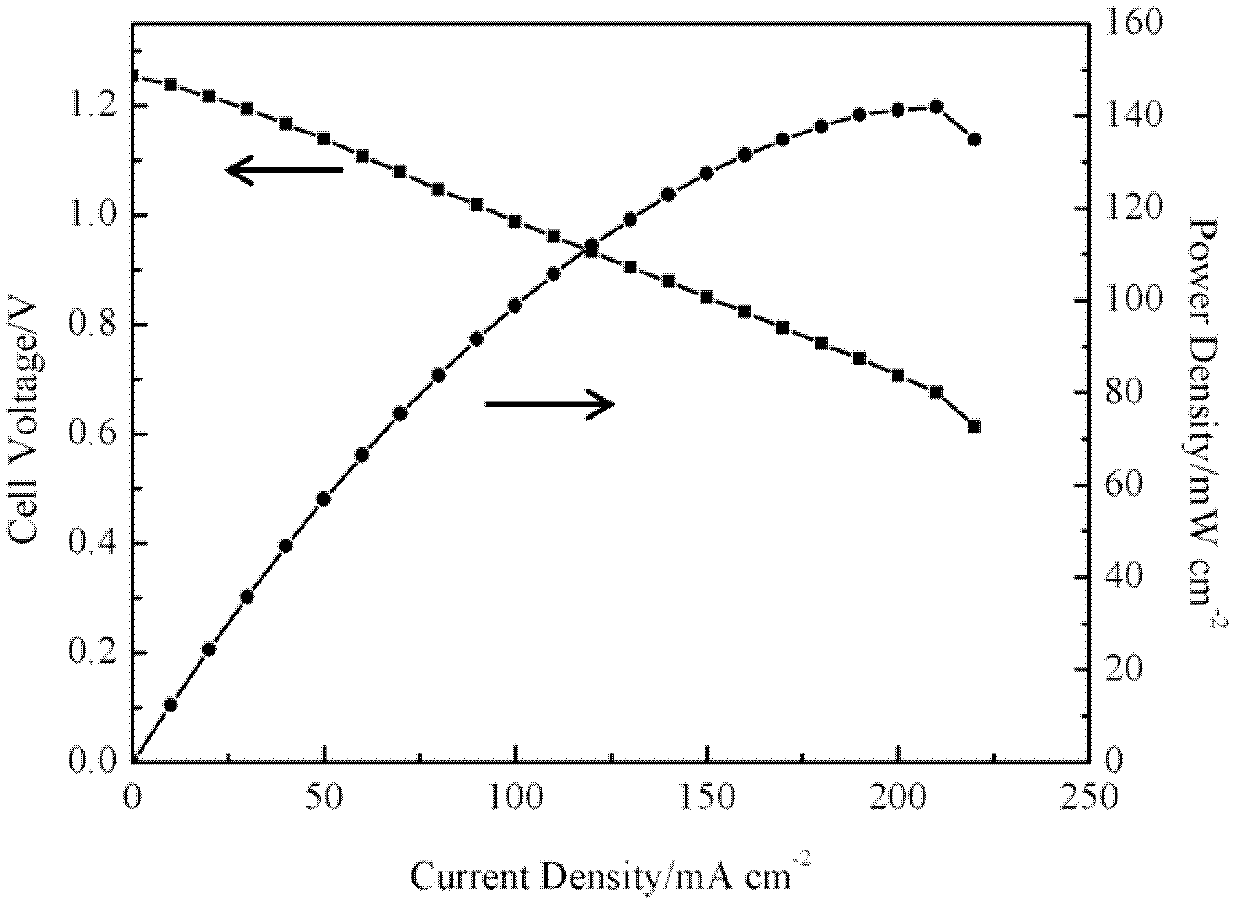Porous membrane for hydrogen-chloride fuel battery, as well as preparation method and application of porous membrane
A technology for hydrogen chloride fuel cells and porous membranes, which is used in fuel cell parts, final product manufacturing, sustainable manufacturing/processing, etc. It can solve the problems of low membrane porosity and adsorbed acid, and achieve high acid retention. , good strength, easy to mass production effect
- Summary
- Abstract
- Description
- Claims
- Application Information
AI Technical Summary
Problems solved by technology
Method used
Image
Examples
Embodiment 1
[0030] Embodiment 1: 1g of high-purity polyethersulfone (PES, molecular weight M w =58000), 0.005g SiO 2 (particle size 20-30nm), 4.6g of analytically pure DMAC and 0.3g of propylene carbonate ester were mixed, magnetically stirred at 60°C for 5h, ultrasonically mixed for 1h, left at room temperature for 3h to defoam, and scraped to form a film at room temperature. A film (thickness 85 μm) was formed by phase transformation from liquid phase to solid phase in the water. After 2 hours, the film was soaked in absolute ethanol for 4 hours, boiled in 1M hydrochloric acid at 40°C for 3 hours, and put into dilute hydrochloric acid for use. . The resulting membrane has an asymmetric structure (see the attached electron microscope photos for the lower surface, upper surface and cross-section of the membrane) figure 1 ), the contact angle of water droplets on the surface of the obtained film is 76.3 °, the porosity is 70.86%, the water absorption rate is 178.4%, the average pore diam...
Embodiment 2
[0031] Embodiment 2: 0.9g PES (M w =58000), 0.1g SiO 2 (particle size 20-30nm), 4.2g DMF and 0.26g PVP were mixed, stirred at room temperature for 1h, ultrasonically mixed for 0.5h, vacuum defoamed at 60°C for 1h, scraped on a glass plate at room temperature, and phase-inverted into a film in 30°C water ( film thickness 70 μm), soak in n-hexane for 1 day, air-dry, and cook in 3M hydrochloric acid at 80°C for 1 hour. The resulting membrane has an asymmetric structure (see the attached electron microscope photos for the lower surface, upper surface and cross-section of the membrane) figure 2), the contact angle of water droplets on the surface of the obtained film is 65.8 °, the porosity is 71.1%, the water absorption rate is 201.6%, the average pore diameter is 12.3nm, and the minimum bubble point pressure is 0.1MPa. The film surface liquid boiled in acid is wiped clean , the ionic conductivity at room temperature was tested to be 0.106S cm -1 .
[0032] The method describ...
Embodiment 3
[0034] Embodiment 3: 0.85g PES (M w =58000), 0.15g SiO 2 (particle size 10-20nm), 4g DMAC and 0.25g glycerol were ultrasonically mixed for 3 hours, stirred at room temperature for 5 hours, degassed in a vacuum oven at 60°C, scraped the film on a glass plate at room temperature, and then put it in water at 50°C for phase inversion to form a film ( 115 μm), after 4 hours, soak the film in absolute ethanol for 12 hours, boil in 3M hydrochloric acid at 60°C for 3 hours, and put it into dilute hydrochloric acid for use. The resulting membrane has an asymmetric structure (see the attached electron microscope photos for the lower surface, upper surface and cross-section of the membrane) Figure 4 ), the contact angle of water droplets on the surface of the obtained membrane is 64.1 °, the porosity is 75.31%, the water absorption is 213.4%, the average pore diameter is 9.46nm, and the minimum bubble point pressure is 0.31MPa. The membrane surface liquid boiled in acid is wiped clean ...
PUM
| Property | Measurement | Unit |
|---|---|---|
| particle diameter | aaaaa | aaaaa |
| particle diameter | aaaaa | aaaaa |
| particle diameter | aaaaa | aaaaa |
Abstract
Description
Claims
Application Information
 Login to View More
Login to View More - R&D
- Intellectual Property
- Life Sciences
- Materials
- Tech Scout
- Unparalleled Data Quality
- Higher Quality Content
- 60% Fewer Hallucinations
Browse by: Latest US Patents, China's latest patents, Technical Efficacy Thesaurus, Application Domain, Technology Topic, Popular Technical Reports.
© 2025 PatSnap. All rights reserved.Legal|Privacy policy|Modern Slavery Act Transparency Statement|Sitemap|About US| Contact US: help@patsnap.com



